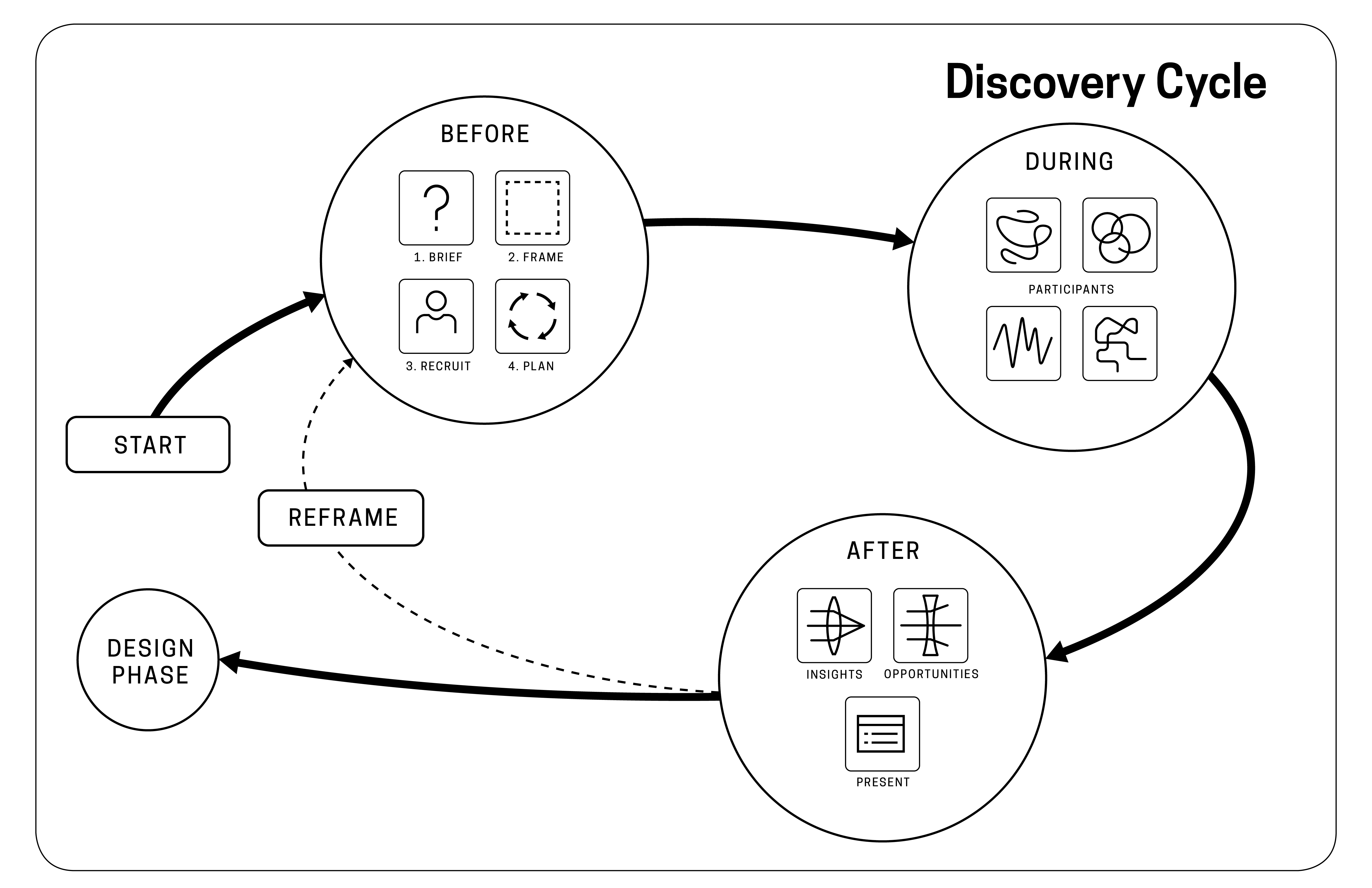Discovery Concept Guide
Discovery Cycle
What is Discovery?
When designers say “discovery”, they’re talking about research. This research can take many forms, but it always includes both secondary or desk research, which means reading white papers and articles on the subject, and primary research, meaning research with the people who are involved in the team’s subject matter.
The Discovery Cycle
Human-Centered Design Discovery should be thought of as a cycle, instead of a linear process. This is because after completing research rounds, frequently one of two things happens after a research phase is completed:
- The team finds new research as well as design opportunities to follow.
- The team finds that the problem that they were investigating was slightly off-target. The research frame needs to be adjusted and discovery should start again.
Below, find an illustration of the Discovery Cycle:

Phases of the Discovery Cycle
Before
Step 1: Project Brief
The project brief is the initial ask, expressed interest, or situation to study. This can come from leadership, one of your partners, or from your own experience or inquiry.
In the first phase, the focus of this guide, you will become an expert in the context for your design project. You will build a problem frame. You will observe situations and talk to people. You will challenge your assumptions by going to the source and being open to what you see and hear.
Step 2: Create a frame of inquiry
A frame of inquiry, or the “How Might We” question, identifies and frames the issue or the situation you are exploring. Use the “How Might We…” prompt to frame your area of inquiry.
Step 3: Recruit research participants
Work within your network (both inside and outside of your agency) to find participants who meet your criteria. Look closely for participants whose life circumstances and experiences align with your frame of inquiry.
Step 4: Plan your research logistics
With your participants lined up, plan out the rest of the research logistics. Reserve a space, gather the tools, draft questions, and establish roles for the team.

During
Step 5: Do the research
As the participants move through your frame of inquiry in their own way, remember that their perceptions and approaches are valid reflections of their reality. That is what you want to understand.
After
Step 6: Synthesis
Synthesis happens after your team has finished the interviews. Now, all members of your team come together and collectively review and analyze the information you’ve gathered. Now is the time to step back, take stock, and tease out common themes and patterns.
Step 7: Opportunities
Insights will emerge during synthesis. The best and most relevant ideas, quotes, and observations, will rise to the top. These can become fields of opportunity to explore.
Step 8: Present
Now is the time to communicate your findings to stakeholders and leadership. Know your audience and tailor your presentation accordingly. Read more about presenting on pages 26-27.

Next Steps: Reframe or On to the Design Phase
Step 9: Reframe (if needed)
Often, after your first round of research and synthesis, you realize how much you didn’t know about what you didn’t know. Though it may not feel like progress, it is. Sometimes, at this stage, you also decide to adjust your “How might we…” question to one that more accurately captures your findings in this initial phase of research. You may also decide to engage in additional rounds of research.
Design Phase
Once your team has completed the research, synthesized the results, presented it, and have support to move forward, then the next step in the Human-Centered Design process is Design.